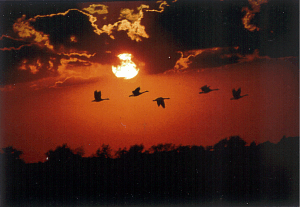Millions of Canadia geese head for Horicon Marsh on their way to warmer climate
Putnam Pit managing editor
Every autumn, birds by the million fill the sky above the Horicon Marsh Wildlife Refuge in central Wisconsin as travelers by the thousands crane their necks for a view of the great fall waterfowl migrations.
 Horicon
Marsh, known as the" Everglades of the North," hosts a seasonal spectacle
-- the annual migration of Canada geese.
Horicon
Marsh, known as the" Everglades of the North," hosts a seasonal spectacle
-- the annual migration of Canada geese.
They start to arrive in mid-September and stay until the winter freeze, but the peak occurs in mid-October, when as many as 200,000 geese settle on the marsh. It's a haven for wildlife watchers, who flock to the flyway for the breathtaking sight of thousands of birds beating their wings against the sky. Honks, whistles, chortles and quacks fill the air from the sun's first glimmer until its evening fall to the west. Prime viewing is at dawn and dusk. At dawn, waterfowl rise by the thousands and fly off to forage in farm fields for miles around. They return at sundown in great V formations, like waves of incoming bombers.
To visitors who see the marsh as a pristine jewel of nature, Bill Volkert, state wildlife educator and naturalist for the Department of Natural Resources here, loves to tell the true story of Horicon Marsh.
It's a story of all the ways people could possibly wrong a piece of
land, from damming the river, then undamming it, to hunting the marsh,
draining it for farming, then letting its wet and heavy peat, ill-suited
for crops, dry out into a wasteland. It's a history that now
makes the marsh a valuable international teaching tool to ecologists
who have visited from as far away as the Mekong Delta of Vietnam.
Today the area thrives -- 32,000 acres of rich wildlife habitat. More than 250 species of birds have been sighted, about half of them nest here. There are black-crowned night herons, double-breasted cormorants, great blue herons, and great egrets. Visitors can also see white-tailed deer, red foxes, coyotes, otters, raccoons and muskrats, year round residents of the area.
One of the best ways to see the geese and other wildlife is to drive the roads surrounding the marsh. A route designated as Wild Goose Parkway makes a 30-mile loop around the marsh, offering spectacular vistas.
Location Approximately 105km northwest of the city of
Milwaukee and 65km west of Lake Michigan, in Dodge and Fond du Lac counties,
in the state of
Wisconsin, north/northeastern USA.
Date of Ramsar Designation 4 December 1990.
Other International Designations None.
National Designations National Wildlife RefugeP (Horicon NWR - 8,489ha; northern two-thirds of the marsh); Wildlife AreaP (Horicon Marsh WA - 4,422ha; southern third of the marsh, State designation); State Natural AreaP (Fourmile Island - 6ha).
Principal Features Horicon Marsh is one of the largest
freshwater wetlands in the USA. It is bounded to the east by the steeply
rising ridge of the Niagaran
escarpment, which bends northeastwards at the northern
end of the site, providing a wide valley towards Lake Winnebago and Green
Bay, thus forming a natural flyway for migratory water birds. The land
lying west of the marsh rises slowly and is dotted with many small pothole
wetlands and several shallow lakes during wet years. The Rock River flows
through the middle of the marsh and is dammed at the town of Horicon (upstream),
thus allowing for control of water levels within the site. Surrounding
areas are farmed intensively. Much of the marsh consists of a thick layer
of peat, overlying clay or sand. Three broad ecological zones have been
identified on the basis of the vegetation communities present. These are:
mainly Typha-dominated; Typha plus other marsh species (e.g. Cyperus esculentus,
Echinochloa sp., Saggitaria sp); and Spartina-dominated. Scattered areas
of higher elevations within the marsh are mostly rocky with bush and tree
cover.
Fourmile Island, the largest such elevation in the marsh,
supports an important mixed nesting colony (rookery) of cormorants and
herons, with up to 1,000 pairs (in total) of Phalacrocorax auritus, Ardea
herodias, Egretta alba and Nycticorax nycticorax. The marsh is an internationally
important staging area for more than
80% of the Mississippi Flyway population of the goose
Branta canadensis (estimated at 1.1 million birds in 1989). A maximum of
700,000 geese was recorded in the vicinity of Horicon during the fall (autumn)
migration in 1989. Staging geese are normally present in fall between mid-September
and mid-December (according to weather conditions) and in spring, from
early March until mid-April. (1a,2a,2b,2c,3a,3b,3c)
